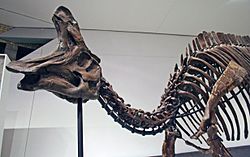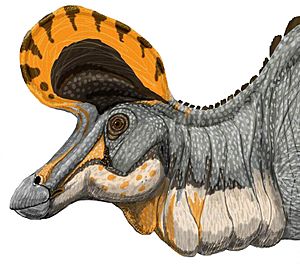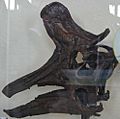Lambeosaurus facts for kids
Quick facts for kids LambeosaurusTemporal range: Upper Cretaceous
|
|
|---|---|
 |
|
| Scientific classification | |
| Kingdom: | |
| Phylum: | |
| Class: | |
| Superorder: | |
| Order: | |
| Infraorder: | |
| Family: | |
| Subfamily: | |
| Genus: |
Lambeosaurus
Parks, 1923
|
Lambeosaurus was a type of dinosaur known for its unique crest and duck-like beak. It belonged to a group called duck-billed dinosaurs. Its large, hollow, bony crest was almost as big as the rest of its skull. Scientists have talked a lot about what this crest was used for.
Lambeosaurus lived a long time ago, during the later Cretaceous period. This was about 76 to 75 million years ago. Fossils of this dinosaur have been found in Alberta (Canada), Montana (USA), and Baja California (Mexico). Only two species from Canada have been studied in detail. One species, Lambeosaurus laticaudus, found in Mexico, was huge! It grew to be about 50 feet (15 meters) long and weighed around 5.6 tons. This makes it the longest-known ornithischian dinosaur. Other species were a bit smaller.
Dr. William A. Parks first described Lambeosaurus in 1923. This was 20 years after Lawrence Lambe, an early Canadian fossil hunter, had studied it. This type of dinosaur lived across much of North America, reaching down into Mexico.
What Lambeosaurus Ate
As a hadrosaurid, Lambeosaurus was a large plant-eating dinosaur. It could walk on two legs or all four. It had a special skull that let it grind its food, much like mammals do when they chew. Its teeth were always being replaced. They were packed into "dental batteries" with over 100 teeth. Only a few of these teeth were used at any one time.
Lambeosaurus used its beak to snip off plant material. It held the food in its jaws with cheek-like organs. It could eat plants from the ground up to about 13 feet (4 meters) high. Lambeosaurus and its relatives had narrower beaks than other duck-billed dinosaurs. This suggests they could pick and choose their food more carefully.
Its Amazing Crest
Like other lambeosaurines, such as Parasaurolophus and Corythosaurus, Lambeosaurus had a very special crest on top of its head. Its nasal passage went all the way through this crest, making it mostly hollow. Scientists have thought of many reasons for what the crest was for.
The most popular ideas are that the crest helped them make sounds or recognize each other. Different species or even males and females of the same species might have had slightly different crests. These differences could have helped them tell each other apart.
Hadrosaurids had large eyes, which means they likely had very good eyesight. They were probably active during the day. This shows that sight was important to these animals. Their sense of hearing also seems to have been strong. In a related dinosaur, Corythosaurus, a thin bone called a stapes was found. This, along with a large space for an eardrum, suggests they had a sensitive middle ear. The part of the inner ear that helps with hearing was also well-developed. If the crest was used to make noise, its different shapes could have created different sounds. This would help dinosaurs recognize their own kind or even their own family members.
Images for kids
-
Type specimen of Procheneosaurus praeceps (AMNH 5340), American Museum of Natural History
-
Skeletons of L. lambei (front) and L. magnicristatus, Royal Tyrrell Museum
-
Specimen of related genus Corythosaurus
See also
 In Spanish: Lambeosaurus para niños
In Spanish: Lambeosaurus para niños










